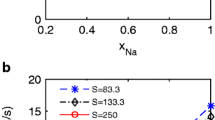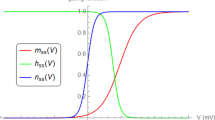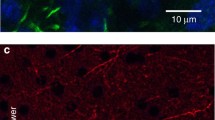Abstract
Assuming a model of facilitated ionic transport across axonal membranes proposed by McIlroy (1975) and extended by McIlroy and Hahn (1978), it is shown that if the selectivity coefficient, πK, of the potassium conducting system ≃59 the permeabilityP Ks, of the periaxonal barrier of the squid giant axon for K+ ions≃(1.2±0.44)×10−4 cm sec−1 and the thickness of the periaxonal space ≃477±168 Å. Using a value (10−4 cm sec−1) ofP Ks in the foregoing range the experimental curves for the steady state membrane ionic conductance versus measured membrane potential difference (p.d.), ϕ, of Gilbert and Ehrenstein (1969) are corrected for the effect of accumulation of K+ in the periaxonal space. This correction is most marked for the axon immersed in a natural ionic environment, whose conductance curve is shifted ≃70mV along the voltage axis in the hyperpolarization direction.
By assuming that the physico-chemical connection between a depolarization of the axonal membrane and the consequent membrane conductance changes is a Wien dissociative effect of the membrane's electric field on a weak electrolyte situated in the axolemma, the position of the peaks of the corrected conductance versus ϕ curves can be identified with zero membrane electric field and hence with zero p.d.across the axolemma. A set of values for the double-layer p.d.s at the axonal membrane interfaces with the external electrolytes in the vicinity of the K+ conducting pores can therefore be deduced for the various external electrolytes employed by Gilbert and Ehrenstein. A model of these double-layer p.d.s in which the membrane interfaces are assumed to possess fixed monovalent negatively charged sites, at least in the neighbourhood of the K+ conducting pores, is constructed. It is shown that, using the previously deduced values for the doublelayer p.d.s, such a model has a consistent, physically realistic solution for the distance between the fixed charged sites and for the dissociation constants of these sites in their interaction with the ions of the extramembrane electrolytes.
Similar content being viewed by others
Literature
Adam, G. 1973. “The Effect of Potassium Diffusion through the Schwann Cell Layer on Potassium Conductance of the Squid Giant Axon.”J. Membrane Biol.,13, 353–386.
Adelman, W. A. Jr., Y. Palti and J. P. Senft. 1973. “Potassium Ion Accumulation in a Periaxonal Space and Its Effect on the Measurement of Membrane Potassium Ion Conductance”.J. Membrane Biol.,13, 387–410.
Bezanilla F. and C. M. Armstrong. 1972. “Negative Conductance Caused by Entry of Sodium and Cesium Ions into the Potassium Channels of Squid Axons”.J. Gen. Physiol.,60, 588–608.
Cole, K. S. 1969. “Zeta Potential and Discrete Versus Uniform Surface Charges”.Biophys. J.,9, 465–469.
Ehrenstein, G. 1977. Private communication.
Frankenhaeuser, B. and A. L. Hodgkin. 1956. “The After-Effects of Impulses in the Giant Nerve Fibres ofLoligo”.J. Physiol.,131, 341–376.
— and —. 1957. “The Action of Calcium on the Electrical Properties of Squid Axons”.J. Physiol.,137, 218–244.
Gilbert, D. L. and G. Ehrenstein. 1969. “Effect of Divalent Cations on Potassium Conductance of Squid Axons: Determination of Surface Charge”.Biophys. J. 9, 447–463.
Grahame, D. C. 1947. “The Electrical Double Layer and the Theory of Electrocapillarity”.Chem. Rev.,41, 441–501.
Hodgkin, A. L. 1964.The Conduction of the Nervous Impulse, p. 23. Liverpool: Liverpool University Press.
— and A. F. Huxley. 1952a. “Currents Carried by Sodium and Potassium Ions Through the Membrane of the Giant Axon ofLoligo”.J. Physiol.,116, 449–472.
— and —. 1952b. “The Components of Membrane Conductance in the Giant Axon ofLoligo”.J. Physol.,116, 473–496.
— and —. 1952c. “The Dual Effect of Membrane Potential on Sodium Conductance in the Giant Axon ofLoligo”.J. Physiol.,116, 497–506.
— and —. 1952d. “A Quantitative Description of Membrane Current and Its Applications to Conductance and Excitation in Nerve”.J. Physiol.,117, 500–554.
Kay, G. W. C. and T. H. Laby, 1975.Tables of Physical and Chemical Constants and Some Mathematical Functions, 14th ed., p. 223. London and New York: Longman.
Mason, D. P. and D. K. McIlroy. 1978. “A Perturbation Solution to the Problem of Wien Dissociation in Weak Electrolytes”.Proc. R. Soc. Lond. A. 359, 303–317.
McIlroy, D. K. 1970a. “A Mathematical Model of the Nerve Impulse at the Molecular Level”.Math. Biosci.,7, 313–328.
— 1970b. “Analysis of the Enzyme Model of the Nerve”.Math. Biosci.,8, 109–129.
— 1970c. “Deductions from the Enzyme Model of the Nerve”.Math. Biosci.,9, 135–146.
— 1975. “Electric Field Distributions in Neuronal Membranes”.Math. Biosci. 26, 191–206.
— and B. D. Hahn. 1978. “Electric Field Distribution, Ionic Selectivity and Permeability in Nerve”.Bull. Math. Biol.,40, 637–649.
Onsager, L. 1934. “Deviations from Ohm's Law in Weak Electrolyte”.J. Chem. Phys.,2, 599–615.
Author information
Authors and Affiliations
Rights and permissions
About this article
Cite this article
McIlroy, D.K. Analysis of potassium conductance in squid giant axons. Bltn Mathcal Biology 41, 343–356 (1979). https://doi.org/10.1007/BF02460816
Received:
Revised:
Issue Date:
DOI: https://doi.org/10.1007/BF02460816




